Heart disease kills more women than any other condition in the United States. Yet when women have heart attacks, doctors often miss the signs or give wrong diagnoses. Women have a 50% higher chance than men[1] of getting the wrong diagnosis after a heart attack.
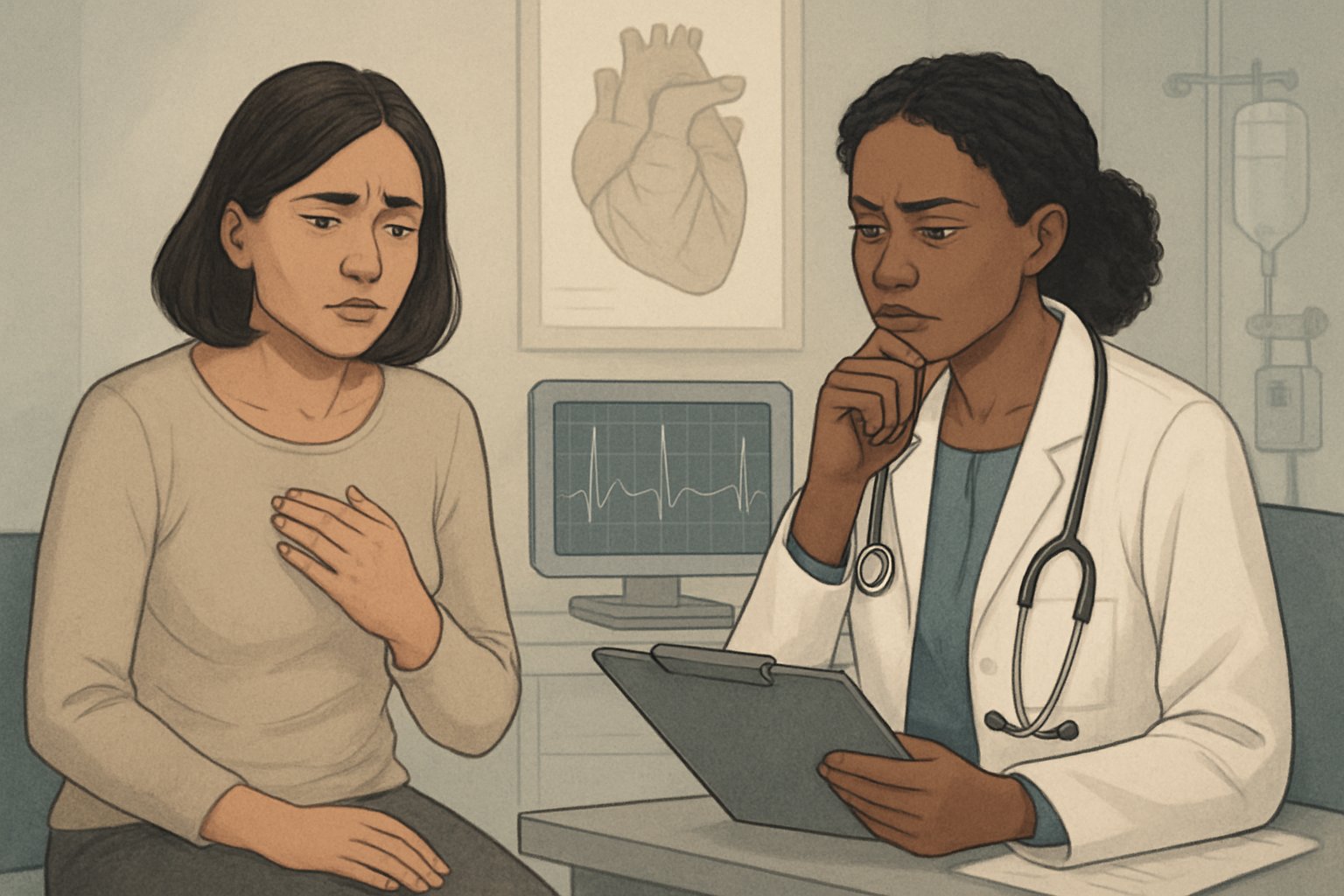
The problem runs deeper than most people realize. More than half of heart attacks in women under 65 happen for different reasons[2] than the blocked arteries that cause most heart attacks in men. Women also show different symptoms that doctors may mistake for stress or anxiety.
This misdiagnosis crisis puts women’s lives at risk. When doctors miss the real cause of a woman’s heart attack, she may get the wrong treatment or miss getting help altogether. Women’s heart disease symptoms are often dismissed or blamed on non-heart problems[3], leading to dangerous delays in care.
Key Takeaways
- Women are 50% more likely than men to receive incorrect heart attack diagnoses from doctors
- More than half of heart attacks in younger women stem from causes other than blocked arteries
- Women often experience different heart attack symptoms that get mistaken for anxiety or stress
Why Are Women Frequently Misdiagnosed for Heart Attacks?
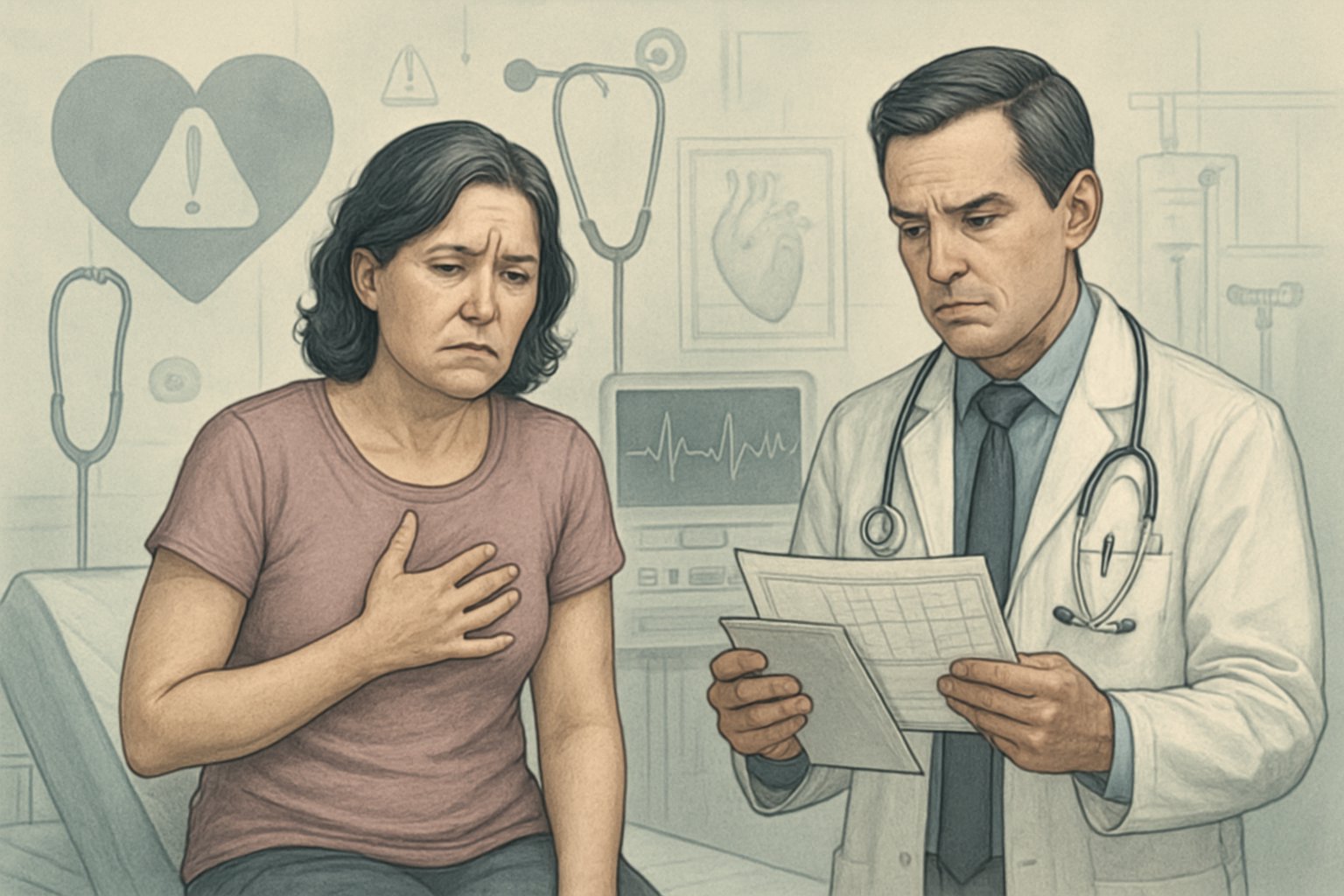
Women face a 50% higher chance of receiving incorrect initial heart attack diagnoses compared to men. This occurs because women experience different symptoms than men and healthcare providers often miss these atypical warning signs.
Prevalence of Misdiagnosis in Women
More than half of heart attacks in women under 65[2] are caused by conditions other than clogged arteries. Research published in the Journal of the American College of Cardiology shows this creates widespread diagnostic errors.
Women had a 50% higher chance than men of receiving wrong initial diagnoses[4] following heart attacks. This happens despite more than 30,000 women being admitted to UK hospitals annually for heart attacks.
Key misdiagnosis statistics:
- 62% of women with heart attacks had no chest pain
- Only 36% of men experienced heart attacks without chest pain
- SCAD (spontaneous coronary artery dissection) is frequently missed in younger women
The misdiagnosis problem affects women across all age groups. However, younger women face particularly high rates of incorrect diagnoses because their symptoms don’t match typical expectations.
Differences Between Men’s and Women’s Heart Attacks
Women experience vastly different heart attack symptoms than men. These differences lead to delayed or incorrect treatment decisions.
Common heart attack symptoms in women:
- Nausea and indigestion
- Shortness of breath
- Back, neck, or jaw pain
- Fatigue
- Dizziness
Men typically experience classic chest pain and pressure. Women’s symptoms are often dismissed as anxiety, stress, or digestive issues instead of cardiac problems.
Women can present with atypical symptoms like nausea and indigestion[2] instead of chest discomfort. This means women aren’t tested for cardiac issues as quickly as men.
Underlying causes also differ:
- 47% of women’s heart attacks come from clogged arteries
- 75% of men’s heart attacks result from arterial blockages
- SCAD affects younger, otherwise healthy women more frequently
These biological differences require different diagnostic approaches. However, most emergency protocols focus on male-pattern symptoms.
Impact of Gender Bias in Healthcare
Healthcare providers often lack awareness that heart disease affects women equally. Heart disease is the leading cause of death for women[5] in the United States, yet this knowledge isn’t widespread among medical professionals.
Gender bias manifests through:
- Dismissing women’s pain as emotional rather than physical
- Attributing symptoms to anxiety or stress
- Failing to order appropriate cardiac tests
- Using male-based diagnostic criteria
Women’s heart disease symptoms are often dismissed or misattributed[5] to non-cardiac issues. This creates dangerous delays in proper treatment.
When SCAD is misdiagnosed, women may receive unnecessary stents. These procedures carry increased complication risks and don’t address the actual problem.
Consequences of misdiagnosis include:
- Delayed treatment leading to more heart damage
- Inappropriate procedures with additional risks
- Lack of proper follow-up care
- Higher mortality rates for women
The medical community needs better training on women’s heart attack presentations. This includes understanding different symptom patterns and underlying causes specific to women’s health.
Distinct Causes of Heart Attacks in Women
Women under 65 experience heart attacks from different causes than men, with more than half stemming from nontraditional factors[6] rather than typical artery blockages. These distinct mechanisms include spontaneous coronary artery dissection and embolism-related events.
Atherosclerosis and Clogged Arteries
Atherosclerosis remains a significant cause of heart attacks in women, but occurs less frequently than in men. This condition involves plaque buildup that narrows coronary arteries.
Only 47% of heart attacks in women result from atherosclerosis[7], compared to 75% in men. The difference becomes more pronounced in younger age groups.
Women’s arteries may develop atherosclerosis differently than men’s. They often show:
- Diffuse narrowing rather than concentrated blockages
- Smaller vessel involvement that’s harder to detect
- Less calcified plaque on imaging tests
These differences can make coronary artery disease harder to diagnose in women. Traditional testing methods work better for detecting the concentrated blockages more common in men.
When atherosclerosis does cause myocardial infarction in women, symptoms may be subtle. Women might experience fatigue, shortness of breath, or jaw pain instead of classic chest pain.
Spontaneous Coronary Artery Dissection (SCAD)
SCAD represents a major cause of heart attacks in younger women. This condition occurs when artery walls tear spontaneously without external trauma.
Spontaneous coronary artery dissection causes 11% of heart attacks in women[6] under 65. In men, SCAD accounts for only 0.07% of heart attacks.
Key characteristics of SCAD:
| Factor | Details |
|---|---|
| Typical patients | Women aged 30-50, often healthy |
| Triggers | Pregnancy, stress, exercise |
| Symptoms | Chest pain, shortness of breath |
| Diagnosis | Often requires specialized imaging |
SCAD cases are frequently misdiagnosed[8], with 55% initially classified incorrectly. Doctors may mistake SCAD for typical atherosclerotic heart attacks.
The condition involves blood pooling between artery wall layers. This creates pressure that blocks blood flow to heart muscle.
Women with SCAD often have no traditional risk factors like high cholesterol or diabetes. This makes the condition particularly challenging to predict or prevent.
Embolism and Other Nontraditional Causes
Secondary myocardial infarction affects 34% of women[6] experiencing heart attacks under age 65. This category includes embolism and supply-demand mismatches.
Embolism-related heart attacks occur when blood clots travel to coronary arteries. These clots often originate from:
- Heart rhythm disorders
- Artificial heart valves
- Blood clotting disorders
Supply-demand mismatch happens when heart muscle needs more oxygen than available. Common triggers include severe anemia, rapid heart rates, or extremely low blood pressure.
Other nontraditional causes affect women more than men. These include coronary spasms, where arteries temporarily constrict and block blood flow.
Women’s nontraditional heart attack causes are often overlooked[3] because symptoms don’t match typical patterns. This leads to delayed treatment and worse outcomes.
Stress-related heart conditions also occur more frequently in women. Emotional or physical stress can trigger heart attacks through various mechanisms beyond simple artery blockages.
Atypical Symptoms of Heart Attacks in Women
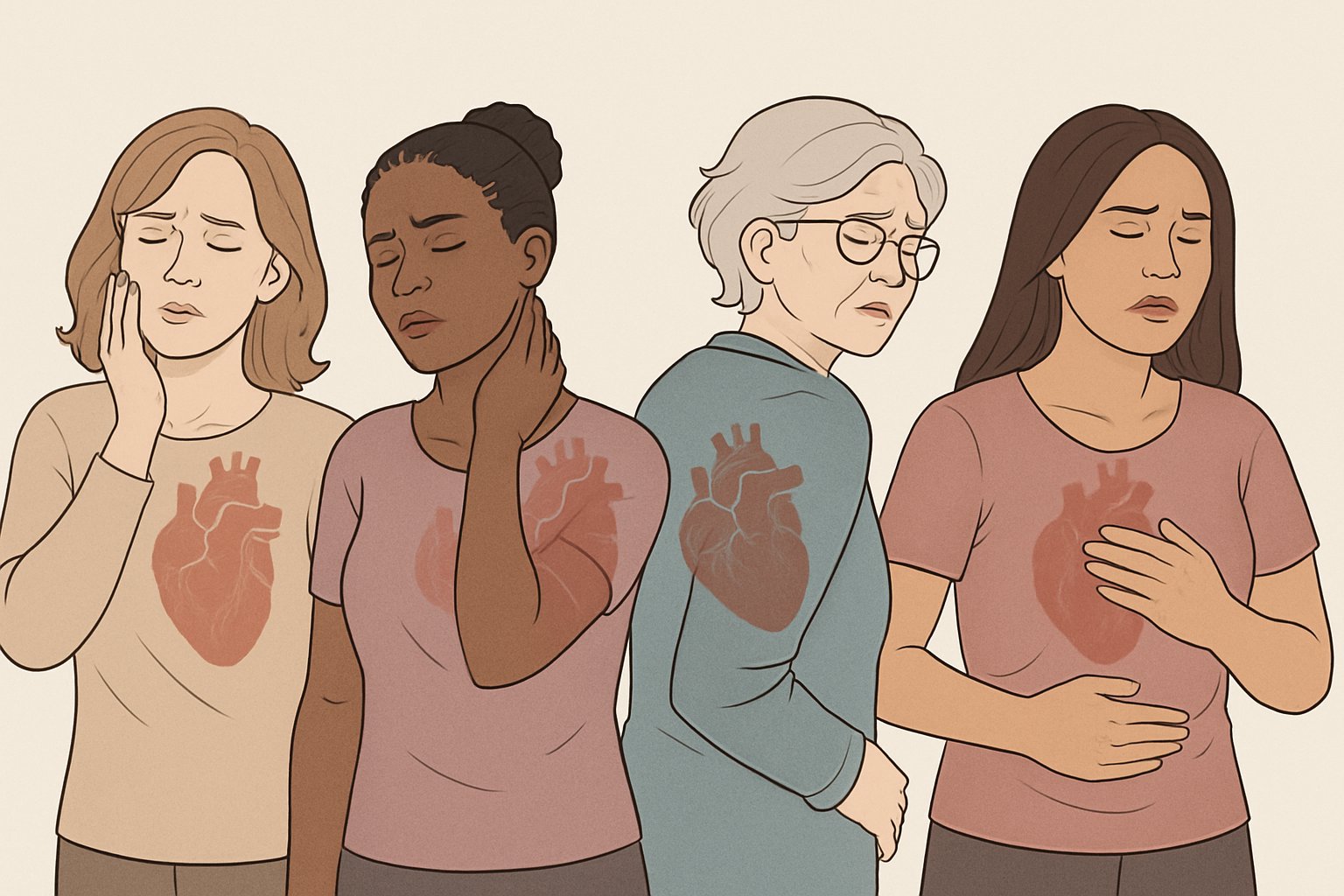
Women often experience heart attack symptoms that differ significantly from the classic chest pain seen in men. These atypical symptoms are frequently dismissed[3] as stress or anxiety, leading to dangerous delays in treatment.
Commonly Overlooked Signs
Many women having heart attacks do not experience the crushing chest pain commonly shown in movies. In fact, 62% of women treated for heart attacks did not have chest pain[9], compared to only 36% of men.
Instead, women often report these symptoms:
- Shortness of breath without chest discomfort
- Nausea or vomiting that seems unrelated to food
- Unexplained fatigue lasting days or weeks
- Jaw, neck, or back pain that comes on suddenly
- Lightheadedness or dizziness
- Pain in one or both arms
Women are more likely to describe their discomfort as burning, aching, or pressure rather than sharp pain. These symptoms can occur alone or together.
The pain may feel like heartburn or muscle strain. This makes it easy to mistake a heart attack for less serious conditions.
Challenges in Recognizing Atypical Symptoms
Healthcare providers often struggle to identify heart attacks in women because medical training historically focused on male symptoms. Women under 55 are seven times more likely than men[3] to be sent home from emergency rooms without proper heart testing.
Gender bias plays a significant role in misdiagnosis. Women are more likely to be seen as anxious or emotional. Their symptoms get blamed on stress or panic attacks instead of heart problems.
Many women also downplay their own symptoms. They worry about seeming dramatic or taking up too much medical attention.
Cultural expectations teach women to put family needs first. This leads them to ignore warning signs that could save their lives.
Consequences of Delayed Diagnosis
Delayed diagnosis of heart attacks in women leads to serious health problems and higher death rates. When treatment gets postponed, more heart muscle dies from lack of blood flow.
Women who receive late treatment face increased risk of heart failure. They also have longer recovery times and more complications.
Women have a 50% higher chance than men[4] of receiving wrong initial diagnosis after a heart attack. This creates a dangerous cycle where symptoms worsen before proper care begins.
Early treatment with medications and procedures can restore blood flow quickly. But these treatments work best within the first few hours of symptom onset.
The window for preventing permanent heart damage closes rapidly. Every minute counts when it comes to saving heart muscle and improving survival rates.
Cardiac Risk Factors Specific to Women
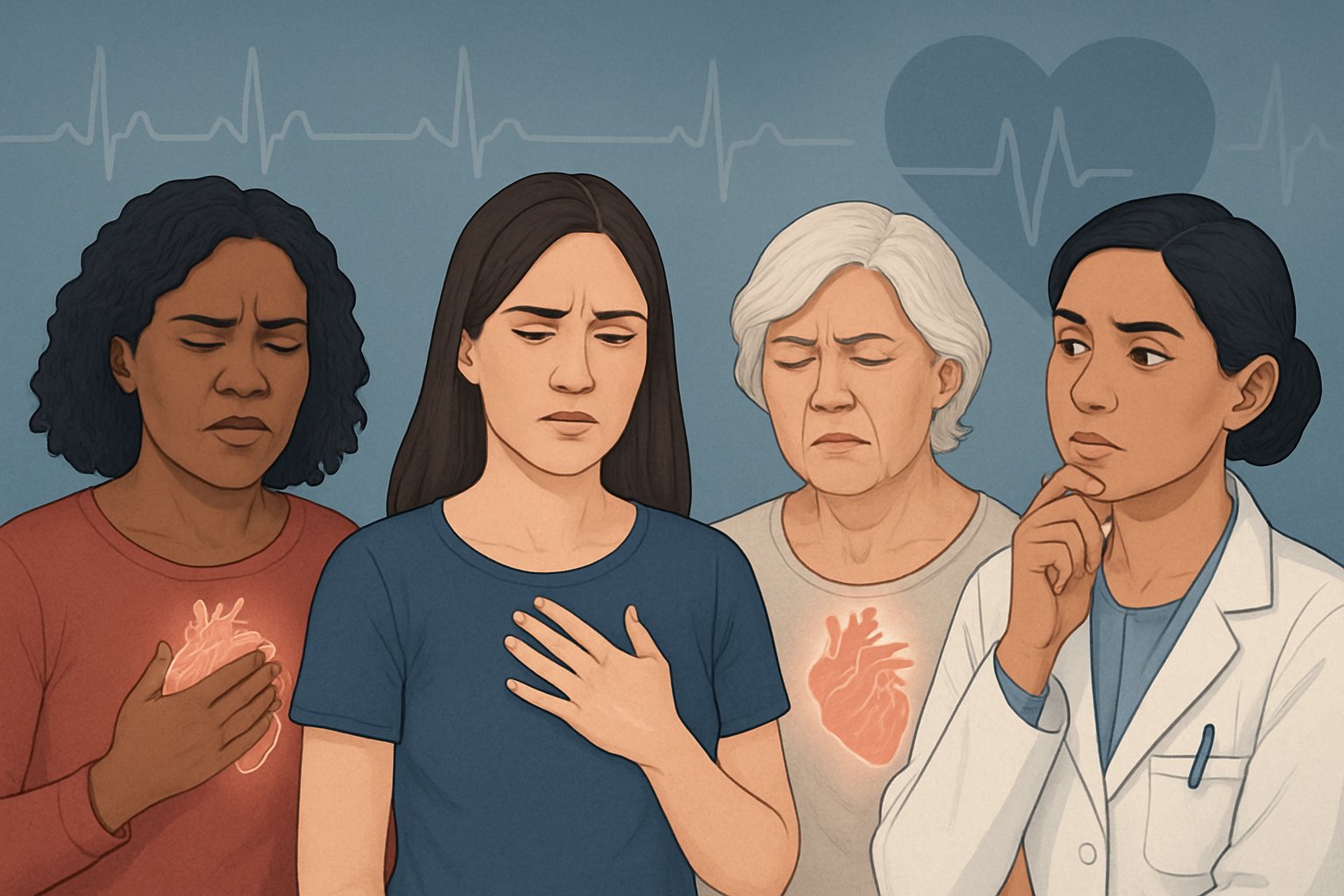
Women face unique cardiac risk factors that differ significantly from men, including hormonal fluctuations, pregnancy complications, and autoimmune conditions. These factors often interact with traditional risk factors like smoking, diabetes, and high blood pressure in ways that increase cardiovascular disease risk.
Hormonal and Biological Risk Factors
Estrogen plays a complex role in women’s heart health throughout their lives. Before menopause, estrogen provides some protection against heart disease by helping maintain healthy cholesterol levels and blood vessel function.
After menopause, estrogen levels drop sharply. This change increases the risk of developing coronary artery disease. Women often see their cholesterol levels rise and blood pressure increase during this time.
Pregnancy brings its own set of risks. Conditions like preeclampsia and gestational diabetes can damage blood vessels. These complications increase the lifetime risk of heart disease even years after delivery.
Pregnancy-related risk factors include:
- High blood pressure during pregnancy
- Gestational diabetes
- Preeclampsia
- Premature delivery
Polycystic ovary syndrome (PCOS) affects hormone levels and metabolism. Women with PCOS often develop insulin resistance and weight gain. These changes increase their risk of diabetes and heart disease.
Autoimmune diseases like lupus and rheumatoid arthritis are more common in women. These conditions cause chronic inflammation that damages blood vessels over time.
Traditional Risk Factors and Their Impact
Traditional cardiac risk factors affect women differently than men. High blood pressure often develops later in women but becomes more common after menopause.
Diabetes poses a particularly high risk for women. Women with diabetes face a greater increase in heart disease risk compared to men with diabetes. The condition also increases the likelihood of having a TIA or stroke.
Smoking damages blood vessels and reduces oxygen in the blood. Women who smoke and take birth control pills face an especially high risk of blood clots. Even light smoking significantly increases cardiovascular risk in women.
High-risk combinations include:
- Smoking + birth control pills
- Diabetes + high blood pressure
- High cholesterol + family history
Women often develop high cholesterol differently than men. They tend to have higher HDL (good) cholesterol when young but experience more dramatic changes during menopause.
Family history plays a strong role in women’s cardiac risk. Having a mother or sister with early heart disease increases risk more than having an affected father or brother.
Role of Lifestyle and Medical Conditions
Physical inactivity affects women’s hearts in unique ways. Women need regular exercise to maintain bone density and muscle mass, especially after menopause. Lack of activity worsens many other risk factors.
Stress impacts women’s cardiovascular health significantly. Chronic stress can lead to high blood pressure and unhealthy coping behaviors like emotional eating or smoking.
Depression and anxiety are more common in women and increase heart disease risk. These conditions often go hand in hand with poor lifestyle choices and medication adherence.
Lifestyle factors with high impact:
- Sedentary behavior: Increases multiple risk factors
- Poor diet: Particularly high-sodium, processed foods
- Sleep disorders: Sleep apnea and insomnia
- Social isolation: Increases stress and depression
Certain medications can affect women’s cardiac risk. Hormone replacement therapy may increase or decrease risk depending on timing and type. Some cancer treatments, particularly chemotherapy, can damage the heart.
Weight gain around the midsection becomes more common after menopause. This type of fat distribution increases the risk of diabetes and high blood pressure more than weight gain in other areas.
Diagnostic and Treatment Gaps
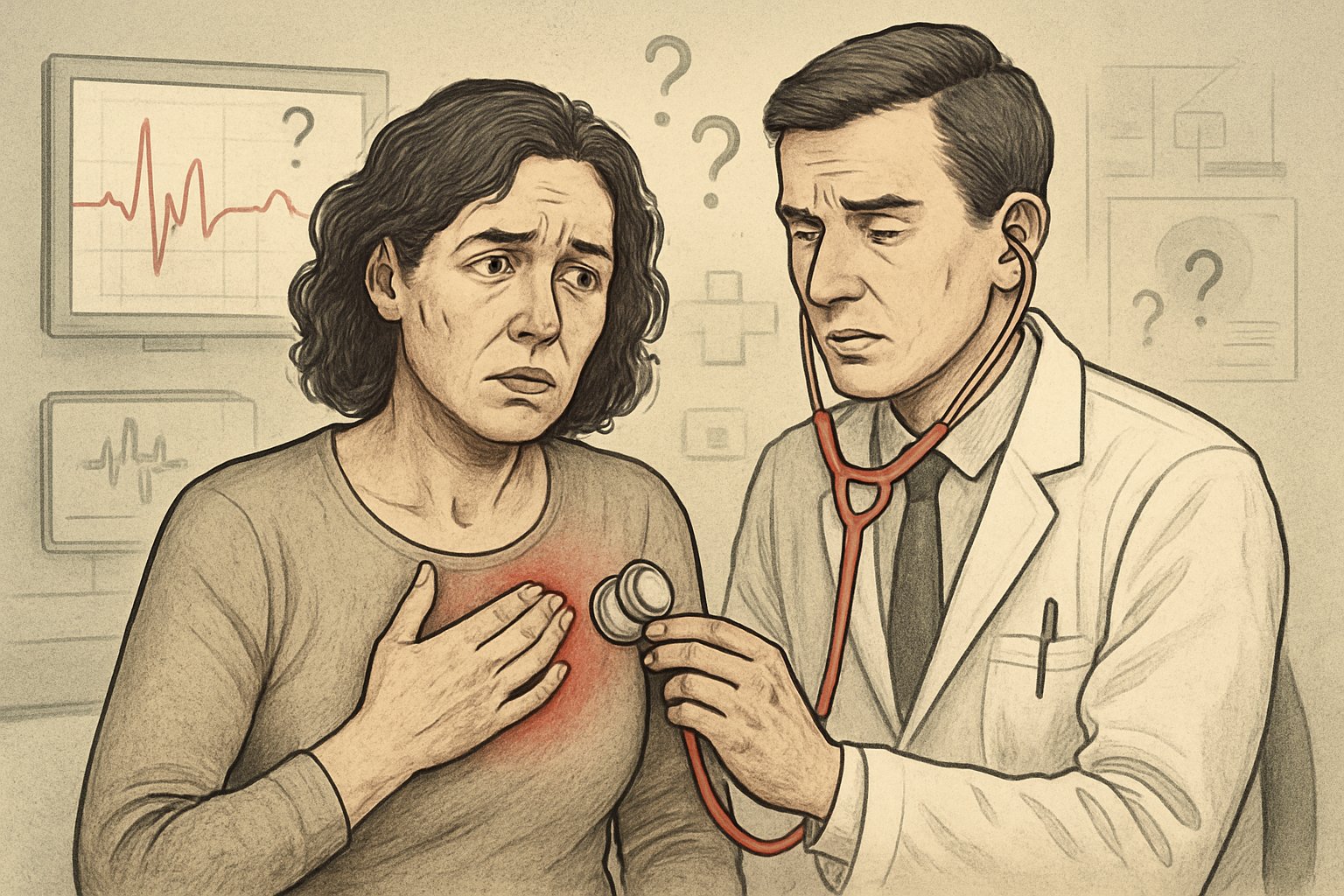
Women face significant barriers in receiving appropriate heart attack diagnosis and treatment. These gaps lead to delayed care, incorrect treatments, and worse health outcomes compared to men.
Underutilization of Diagnostic Tests
Healthcare providers often delay or skip important heart tests for women. Women with heart attacks are less likely to receive coronary angiography[10] than men with similar symptoms.
The numbers show clear discrimination. Women receive angiography 47% less often than men. They also get revascularization procedures 58% less frequently.
Key diagnostic gaps include:
- Delayed ECG testing
- Less frequent stress testing
- Reduced access to cardiac catheterization
- Longer wait times for interventional cardiology consultations
Young women face the worst treatment gaps. Healthcare workers tell 53% of young women their heart symptoms are not cardiac. Only 37% of men receive this dismissive response.
These delays have serious consequences. Women wait an average of 30 minutes longer than men to receive life-saving treatment during heart attacks.
Misclassification of Heart Attack Types
Different types of heart attacks affect women more than men. SCAD (spontaneous coronary artery dissection) causes many heart attacks in women but gets misdiagnosed[2].
Women also experience more heart attacks without blocked arteries. These attacks happen when:
- Small blood vessels malfunction
- Coronary arteries spasm suddenly
- Heart muscle becomes inflamed
Standard tests miss these conditions. Coronary angiography shows normal large arteries but misses small vessel problems.
Common misclassifications:
- SCAD labeled as anxiety or stress
- Microvascular disease called “normal” heart function
- Takotsubo cardiomyopathy dismissed as panic attacks
Women with ischemic heart disease often get different diagnoses first. Doctors may suggest hormonal problems, anxiety, or muscle strain instead of heart disease.
Consequences of Incorrect Treatment
Wrong diagnoses lead to dangerous treatment delays. Women receive inappropriate medications or miss critical interventions entirely.
Incomplete revascularization happens more often in women[10]. This means doctors don’t fully restore blood flow to the heart muscle.
Treatment gaps create lasting problems. Women have 68% less chance of being angina-free nine months after heart procedures. Their coronary artery disease symptoms continue longer than men’s symptoms.
Major treatment consequences:
- Two times higher death rates after heart attacks
- Increased risk of future cardiac events
- Longer recovery periods
- More disability from heart disease
Medication errors compound the problem. Women receive guideline-recommended drugs less often than men. They get fewer blood thinners and cholesterol medications after heart attacks.
The gap widens over time rather than closing. Current management decisions make treatment differences between men and women larger, not smaller.
Improving Outcomes for Women’s Heart Health
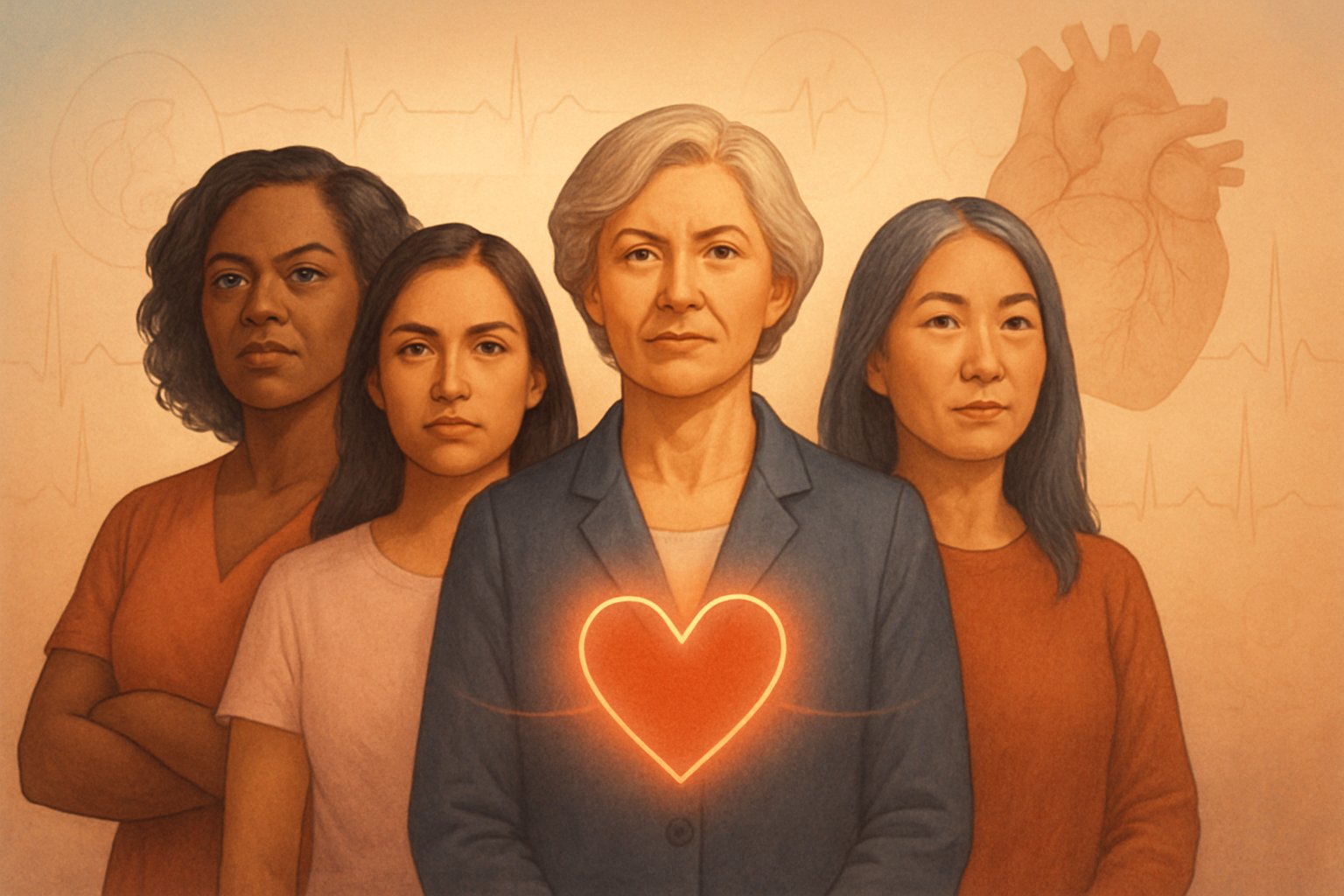
Better diagnosis and treatment require education for both patients and doctors, updated medical research that includes women, and specific prevention strategies that address how heart disease affects women differently than men.
Raising Awareness in Patients and Clinicians
Women need to know their heart attack symptoms often differ from men’s experiences. Many women don’t get the classic crushing chest pain shown in movies.
Common women’s heart attack signs include:
- Nausea and vomiting
- Extreme fatigue
- Pain in jaw, neck, or back
- Shortness of breath
- Feeling like something is wrong
Doctors also need better training about women’s heart health. Research shows women wait 11 minutes longer than men[11] to get emergency care for the same chest pain symptoms.
Medical schools should teach that women’s heart attacks look different. Emergency room staff need to take women’s symptoms seriously instead of dismissing them as anxiety or panic attacks.
Advancing Research and Guidelines
Most heart disease research has focused on men for decades. This has left big gaps in understanding how heart disease works in women.
Studies show cardiovascular disease in women remains understudied and underdiagnosed[10] compared to men. Women have different types of heart problems that don’t show up on standard tests.
Research priorities include:
- How hormones affect heart health
- Small vessel disease in women
- Coronary artery spasms
- Pregnancy-related heart conditions
New diagnostic tools are being developed. Some hospitals now offer special tests for small artery disease that affects more women than men.
Medical guidelines need updates based on women-specific research. Treatment protocols should account for how women respond differently to heart medications.
Strategies for Prevention and Better Care
Prevention starts with knowing risk factors that affect women more than men. These include autoimmune diseases, depression, and pregnancy complications.
Key prevention steps:
- Regular blood pressure checks
- Cholesterol testing starting at age 20
- Diabetes screening
- Stress management
- Not smoking
Women should find doctors who understand female heart health. Specialized women’s heart centers offer comprehensive testing and treatment designed for women’s unique needs.
Healthcare systems need to track how often they miss heart attacks in women. This data helps identify where improvements are needed most.
Better training for paramedics and emergency staff can prevent dangerous delays. Women’s symptoms should trigger the same urgent response as men’s symptoms.
Frequently Asked Questions
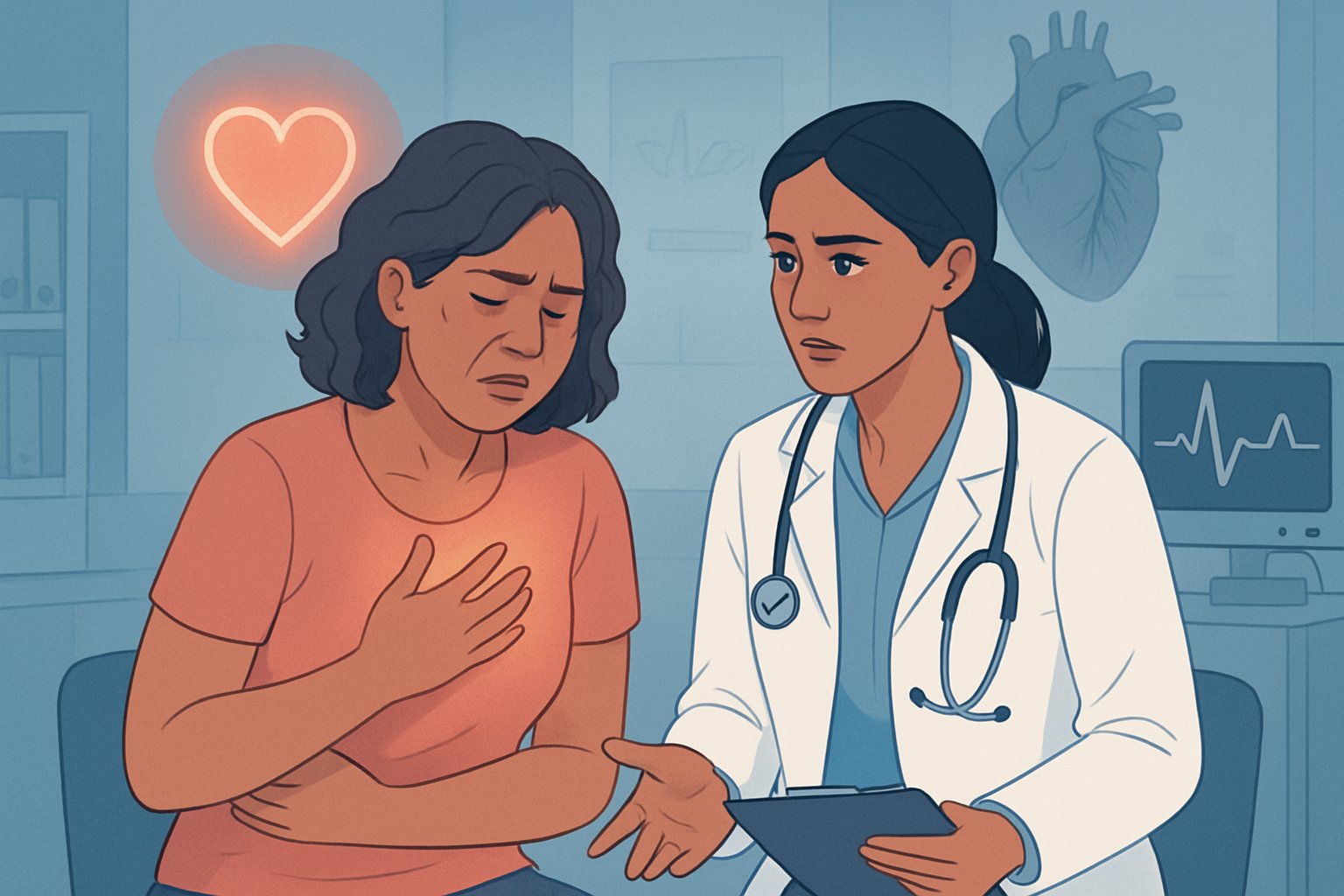
Women face unique challenges when it comes to heart attack diagnosis and recognition. Understanding the differences in symptoms, risk factors, and diagnostic barriers can help women advocate for better care.
What are the common symptoms of heart attacks in women that are often overlooked?
Women often experience symptoms that differ from the classic chest pain typically seen in men. Research shows that 62% of women who had heart attacks did not have chest pain[9], compared to only 36% of men.
Common overlooked symptoms include nausea and indigestion. These feelings can be mistaken for stomach problems rather than heart issues.
Women may also experience unusual fatigue, shortness of breath, or pain in the jaw, neck, or back. Sweating and dizziness are other warning signs that healthcare providers sometimes dismiss.
These symptoms can appear days or weeks before a heart attack occurs. Women should pay attention to any new or unusual feelings in their body.
How does heart attack presentation differ between men and women?
Men typically experience the classic crushing chest pain that radiates down the left arm. This makes their heart attacks easier to recognize and diagnose quickly.
Women are more likely to have subtle symptoms that seem unrelated to the heart. Women can present with atypical symptoms like nausea and indigestion instead of classic cardiac chest discomfort[2].
The causes of heart attacks also differ between genders. More than half of heart attacks in women under 65 are caused by factors other than clogged arteries[6], while 75% of men’s heart attacks come from blocked arteries.
Women are more likely to experience spontaneous coronary artery dissection (SCAD). This condition involves tearing in the artery wall rather than blockages from plaque buildup.
What are the risk factors for heart attacks that are unique to women?
Hormonal changes play a major role in women’s heart attack risk. Pregnancy and the postpartum period increase the chance of certain types of heart attacks.
Menopause brings additional risks as estrogen levels drop. This hormonal shift affects blood vessel health and can make heart problems more likely.
SCAD occurs more often in healthy women who have recently given birth. It can also happen during menopause when hormone levels change dramatically.
Fibromuscular dysplasia affects women more than men. This blood vessel disease makes artery walls weaker and more prone to tearing.
Autoimmune diseases like lupus and rheumatoid arthritis increase heart attack risk. These conditions are more common in women than men.
Why are heart disease and heart attacks frequently misdiagnosed in women?
Healthcare providers often miss women’s heart attacks because the symptoms look different. Women had a 50% higher chance than men of receiving the wrong initial diagnosis following a heart attack[4].
Many doctors still think of heart disease as mainly affecting men. There is a lack of awareness that heart disease impacts women[2] even though it is the leading cause of death for women.
Women’s symptoms are often blamed on anxiety, stress, or hormones. This leads to delays in proper testing and treatment.
The medical system was built around male heart attack patterns. Testing and treatment protocols work better for men’s typical presentation.
SCAD is often misdiagnosed as a regular blocked artery heart attack. This leads to wrong treatments that can cause more harm than good.
How do healthcare providers improve diagnosis of heart disease in women?
Doctors need better training on how heart attacks look different in women. Understanding atypical symptoms helps providers order the right tests sooner.
Advanced imaging techniques can spot SCAD and other women-specific heart problems. Coronary angiography and CT scans help identify the true cause of heart attacks.
Healthcare systems should use protocols designed for women’s heart attack patterns. This includes asking about specific symptoms that women experience more often.
Medical schools need to teach more about women’s heart disease. Future doctors should learn that heart problems affect both genders equally.
Emergency departments should have checklists for women’s heart attack symptoms. This helps staff recognize warning signs that might otherwise be missed.
What should women know about the risks and signs of heart attacks specific to their gender?
Women should know that heart disease kills more women than any other condition. Heart disease is the leading cause of death for women in the United States[3].
Pay attention to unusual fatigue, nausea, or pain in areas other than the chest. These symptoms are just as serious as chest pain in men.
Women should advocate for themselves if doctors dismiss their symptoms. Ask specifically about heart-related causes for unusual feelings.
Know your family history and personal risk factors. Pregnancy complications, autoimmune diseases, and early menopause all increase heart attack risk.
Don’t wait to seek help if you feel something is wrong. Early treatment saves lives and prevents long-term heart damage.
Trust your instincts about your body. Women often know when something feels different or concerning about their health.
References
- Women have 50 per cent higher chance misdiagnose after heart attack. https://www.bhf.org.uk/what-we-do/news-from-the-bhf/news-archive/2016/august/women-are-50-per-cent-more-likely-than-men-to-be-given-incorrect-diagnosis-following-a-heart-attack Accessed October 29, 2025
- More than half of heart attacks in women under 65 happen for different reasons. https://www.womenshealthmag.com/uk/health/female-health/a67959981/scad-heart-attack-women-misdiagnosis-study/ Accessed October 29, 2025
- “Ms. Diagnosed”: Why Women’s Heart Disease Symptoms Are Often Overlooked. https://www.womenheart.org/womens-heart-disease-symptoms-overlooked/ Accessed October 29, 2025
- Misdiagnosis of heart attacks in women - Heart Matters. https://www.bhf.org.uk/informationsupport/heart-matters-magazine/medical/women/misdiagnosis-of-heart-attacks-in-women Accessed October 29, 2025
- 404. https://www.womensheart.org/womens-heart-disease-symptoms-overlooked/ Accessed October 29, 2025
- beckershospitalreview.com. https://www.beckershospitalreview.com/cardiology/cause-of-heart-attacks-among-women-misdiagnosed-mayo-clinic/ Accessed October 29, 2025
- Just a moment.... https://medicalxpress.com/news/2025-09-reveals-hidden-heart-younger-adults.pdf Accessed October 29, 2025
- New Study Uncovers Hidden Heart Attack Causes in Younger Adults, Especially Women. https://www.dicardiology.com/content/new-study-uncovers-hidden-heart-attack-causes-younger-adults-especially-women Accessed October 29, 2025
- 62% of women treated for heart attacks did not have chest pain. https://womensheartalliance.org/wp-content/uploads/2024/01/wha-2024-womensheart-misdiagnosis-toolkit_08.pdf Accessed October 29, 2025
- Just a moment.... https://www.ahajournals.org/doi/full/10.1161/CIRCINTERVENTIONS.121.011714 Accessed October 29, 2025
- Women’s Heart Attacks Are Often Misdiagnosed. Dr. Harmony Reynolds Is on a Mission to Change That.. https://nyulangone.org/news/womens-heart-attacks-are-often-misdiagnosed-dr-harmony-reynolds-mission-change Accessed October 29, 2025
